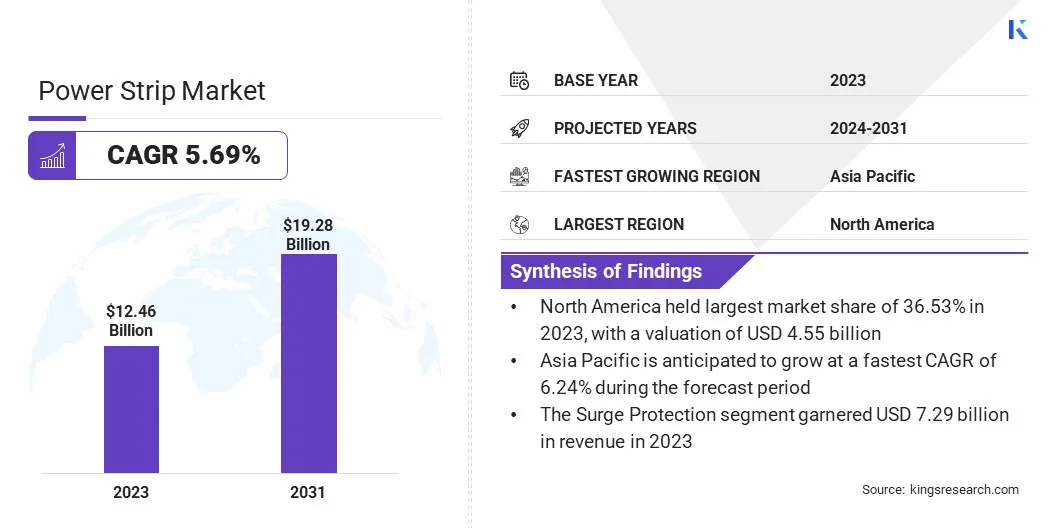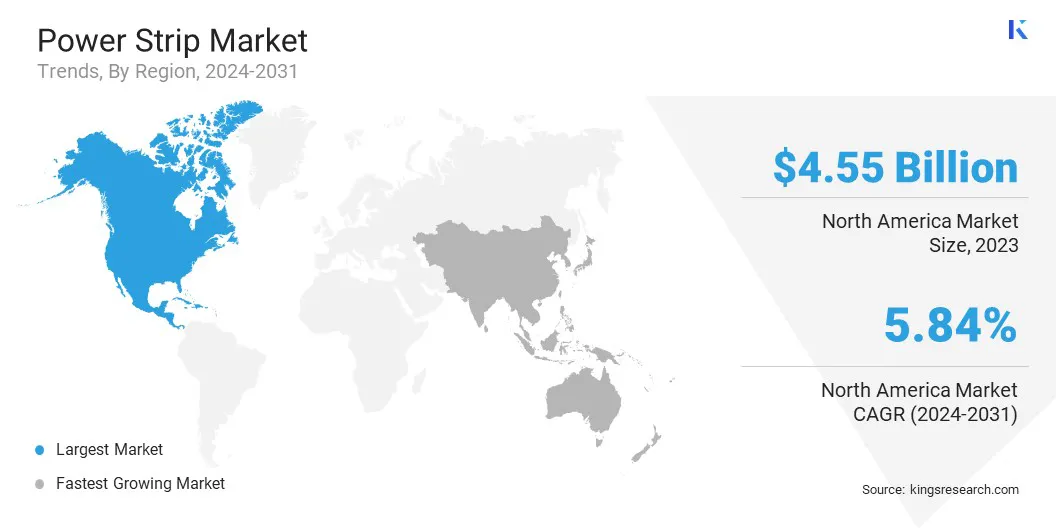Market Definition
The market encompasses the manufacturing and sitribution of power strips. A power strip is an electrical device that enable multiple electronic devices to connect to a single power source. These trips often include multiple outlets and may feature surge protection, USB ports, and power control switches.
Power Strip Market Overview
Global power strip market size was valued at USD 12.46 billion in 2023, which is estimated to be valued at USD 13.09 billion in 2024 and reach USD 19.28 billion by 2031, growing at a CAGR of 5.69% from 2024 to 2031. The expansion of remote work and home offices has significantly increased the demand for power strips with multiple outlets and USB ports, driven by the increased need for device charging.
Major companies operating in the power strip industry are Belkin, Leviton Manufacturing Co., Inc., Schneider Electric SE, Legrand North America, LLC, Cyber Power Systems (USA), Inc., Falconer Electronics, Delixi Group Co.,Ltd, Hubbell, Anker Innovations Technology Co., Ltd, BASEUS TECHNOLOGY (US) INC, Portronics Digital Private Limited., Tessan, Elcom International, D-Link (India) Limited, LDNIO, and others.
The power strips market is a key segment of the electrical accessory industry. Market expansion is fueled by the need for efficient power distribution in both residential and commercial spaces. With increasing reliance on multiple electronic devices, power strips are essential for providing additional outlets and surge protection.
The market is characterized by a wide range of products, including basic power strips and smart power strips with advanced features, catering to diverse consumer needs for safety, convenience, and functionality.
- In October 2024, TESSAN showcased its latest power strips and wall outlet extenders at the Global Sources Mobile Electronics Show, featuring upgraded USB-C functionality, refined designs, and enhanced anti-slip features, redefining home charging solutions.

Key Highlights:
- The global power strip market size was recorded at USD 12.46 billion in 2023.
- The market is projected to grow at a CAGR of 5.69% from 2024 to 2031.
- North America held a share of 36.53% in 2023, valued at USD 4.55 billion.
- The common power strip segment garnered USD 5.78 billion in revenue in 2023.
- The surge protection segment is expected to reach USD 11.57 billion by 2031.
- The household segment is anticipated to witness the fastest CAGR of 6.89% over the forecast period
- Asia Pacific is projected to grow at a CAGR of 6.24% through the projection period.
Market Driver
Increase in Remote Working
The rise of remote work has led to an increase in electronic devices per household, creating a strong demand for power strips with multiple outlets and USB ports. These power strips offer enhanced convenience by allowing users to charge multiple devices simultaneously, reducing clutter and improving organization.
As more people set up home offices, the need for reliable power solutions grows, making multi-functional power strips essential for maintaining productivity and efficiency in modern workspaces.
- In May 2023, Tessan introduced advanced surge protector power strips with USB ports, offering efficient charging solutions for homes and offices. These power strips feature wide-spaced outlets, surge protection, and space-saving designs, aimed at addressing the growing demand for reliable power solutions.
Market Challenge
Quality and Safety Concerns
Quality and safety concerns present a significant challenge to the development of the power strips market, with risks such as overheating, fire hazards, and device malfunctions. Poorly designed power strips can cause short-circuits, leading to fires or equipment damage.
To mitiagte these risks, manufacturers are incorporating advanced safety features such as surge protection, overcurrent protection, and thermal fuses. Additionally, certifications ensure compliance with strict safety standards, enhancing product reliability and consumer trust.
Market Trend
Surge Protection and Advanced Safety Features
The power strips market is witnessing a notable shift toward surge protection and enhanced safety features, propelled by rising consumer awareness of electrical hazards. The increasing use of sensitive electronics has fueled demand for power strips with built-in surge protection to prevent devices from power spikes.
Additionally, fire-resistant materials, such as high-temperature resistant plastics, are being incorporated to mitigate electrical fire risks, enhancing overall safety and reliability.
Power Strip Market Report Snapshot
|
Segmentation
|
Details
|
|
By Type
|
Smart Power Strip, Common Power Strip, Specialized Power Strip
|
|
By Protection Type
|
Surge Protection, Fuse-based Protection
|
|
By Application
|
Household, Commercial, Industrial
|
|
By Region
|
North America: U.S., Canada, Mexico
|
|
Europe: France, UK, Spain, Germany, Italy, Russia, Rest of Europe
|
|
Asia-Pacific: China, Japan, India, Australia, ASEAN, South Korea, Rest of Asia-Pacific
|
|
Middle East & Africa: Turkey, UAE, Saudi Arabia, South Africa, Rest of Middle East & Africa
|
|
South America: Brazil, Argentina, Rest of South America
|
Market Segmentation
- By Type (Smart Power Strip, Common Power Strip, and Specialized Power Strip): The common power strip segment earned USD 5.78 billion in 2023 due to high demand across residential and commercial applications.
- By Protection Type (Surge Protection and Fuse-based Protection): The surge protection segment held a share of 58.54% in 2023, largely attributed to increasing concerns over electronic device safety from power surges.
- By Application (Household, Commercial, and Industrial): The household segment is projected to reach USD 10.06 billion by 2031, owing to rising adoption of electrical appliances and home automation systems.
Power Strip Market Regional Analysis
Based on region, the global market has been classified into North America, Europe, Asia Pacific, Middle East & Africa, and Latin America.

North America power strip market share stood at around 36.53% in 2023, va;ued at USD 4.55 billion. This dominance is reinforced by the high demand for reliable electrical solutions in both residential and commercial sectors. The region's advanced infrastructure, coupled with increasing adoption of smart homes and electronic devices, is bolstering regional market growth.
Additionally, the presence of leading manufacturers and a well-established distribution network strengthens North America's leading market position. This dominance is expected to be facilitated by surging demand for surge protection and energy-efficient features,.
Asia Pacific market is set to grow at a robust CAGR of 6.24% over the forecast period. This rapid growth is propelled by rapid industrialization and urbanization. The increasing use of electronic devices in households and businesses, combined with rising disposable incomes, stimulates this expansion.
Furthermore, the growth of e-commerce platforms and a growing middle-class population in the region are spurring the demand for affordable, high-quality power strips. Countries such as China, India, and Japan are at the forefront of this growth, supported by ongoing technological advancements.
Regulatory Frameworks
- In the US, power strips must comply with the National Fire Protection Association (NFPA) 1 Fire Code, which mandates direct connections to permanent outlets and prohibits daisy-chaining to prevent fire hazards.
- In the EU, power strips must display the CE mark, signifying compliance with safety, health, and environmental standards for the European Economic Area (EEA).
Competitive Landscape
Companies operating in the power strips market are focusing on innovation to meet evolving consumer needs, integrating features such as fast charging, surge protection, and USB ports. They are also enhancing safety with flame-resistant materials, child-proof designs, and energy-efficient solutions while improving aesthetics for greater usability in homes and workplaces.
- In August 2024, Huntkey launched the 6-in-1 fast charging station F20 in Vietnam. Featuring a cat-paw design, it supports PD 20W fast charging and various power socket specifications, ensuring enhanced safety, efficiency, and user convenience.
List of Key Companies in Power Strip Market:
- Belkin
- Leviton Manufacturing Co., Inc.
- Schneider Electric SE
- Legrand North America, LLC
- Cyber Power Systems (USA), Inc.
- Falconer Electronics
- Delixi Group Co.,Ltd
- Hubbell
- Anker Innovations Technology Co., Ltd
- BASEUS TECHNOLOGY (US) INC
- Portronics Digital Private Limited.
- Tessan
- Elcom International
- D-Link (India) Limited
- LDNIO


